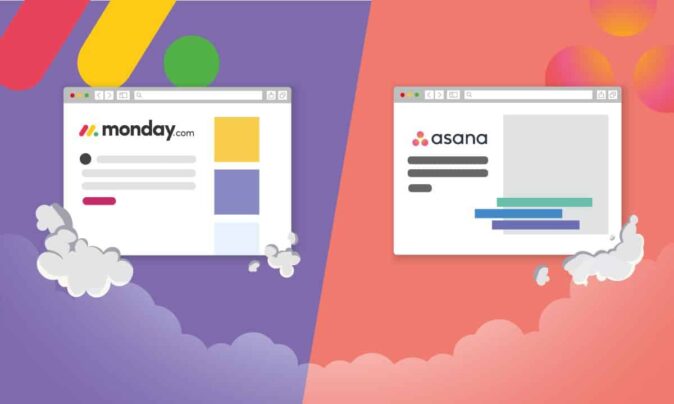There’s no way to completely eliminate the risk of things going wrong with your project.
But you can prepare to overcome project management challenges by keeping solutions handy before they happen—or at least reduce their impact on the project’s success.
This post will share the most common project management challenges, their signs and symptoms, and how you can solve or mitigate them.
Sound like a plan?
Let’s get to the first big challenge.
1. Scope creep
Project scope creep means adding new requirements to a project that were not initially agreed upon. It’s also known as “constantly changing project scope.”p
This happens with clients who always want “one more thing” at every meeting. Eventually this hsnowballs into project requirements that don’t fit in the initial schedule and budget.
Scope creep is one of the top project management challenges a project manager struggles with. According to an IEEE survey, 92% of projects failed because of poor scope management.
Scope creep spells disaster for your budget and your bottom line because:
- Extra work that isn’t budgeted for adds to your agency’s costs
- Unrealistic deadlines
- Change of scope leads to redoing tasks which prevents you from getting on with billable tasks
So, how do you defend yourself against scope creep?
Signs of scope creep
- Constantly adjusting project schedule to accommodate new client requirements
- Always looking to find and allocate new resources to the projects to meet new requirements
- Feeling jaded about completed projects and feeling like what you’re invoicing doesn’t match the effort you’ve put in
How to deal with scope creep?
Decide on the project’s goals and requirements. Document them in your project scope. And get the client to sign off the scope document.
If you follow the Waterfall project management methodology, this is fairly straightforward. At the end of the requirement gathering, analysis, and planning phase, you should have the project scope ready.
But how do you define project scope for an Agile project?
Well, you don’t.
Instead, create a scope document for each iteration of your project.
Waterfall or iterative, a scope document is an excellent way to freeze a project’s requirements.
It also helps set boundaries with a client and avoids miscommunication. You can always refer to the scope document when a client requests something out of scope.
And if something is critical to a project, revise the scope along with the deadlines. At any cost avoid aiming for unrealistic deadlines after a scope change.
During implementation, use tools to track project progress against your original scope document to ensure it’s all going as close to the plan as possible.
Tracking each task as the project chugs along will allow you to make adjustments to your original project schedule to ensure that deadlines are met.
2. Lack of project visibility
Is there constant confusion in your team about who’s doing what (and when)? Does your team need to constantly rework on tasks? Do stakeholders keep asking for status updates over and over again?
You may be suffering from our next project management challenge—lack of project visibility.
Project visibility is an overview of what’s happening in your project. This includes the schedule, progress, milestones, and roadblocks.
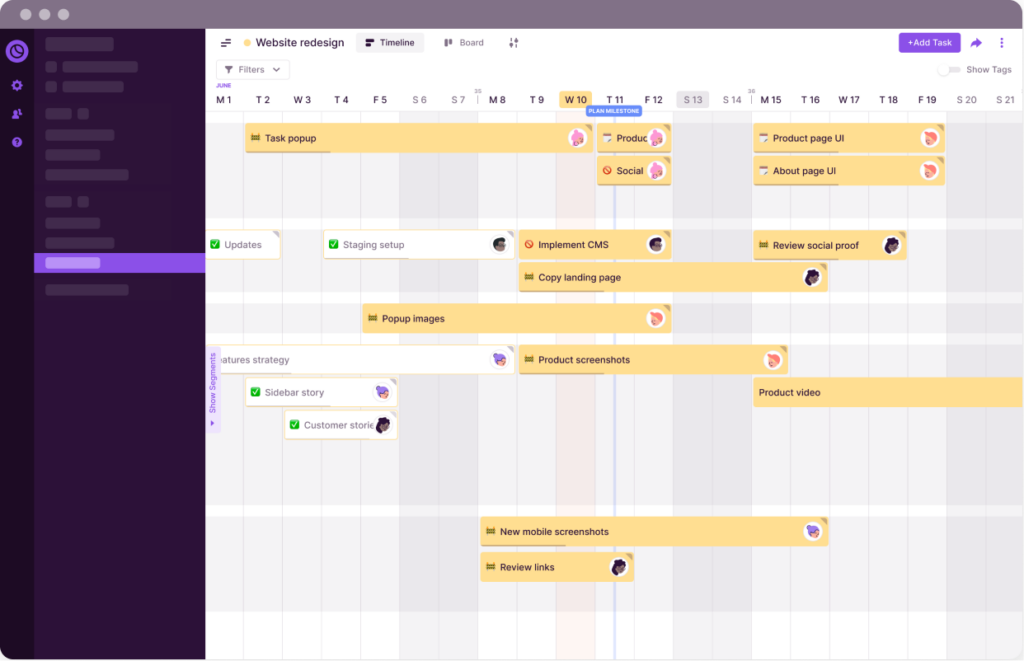
Visibility issues also stem from poor communication within the team.
For example, the project manager finds team members have pending tasks from older projects even after they’ve been allocated to a new project.
The second biggest reason is using inefficient tools, such as Excel for project management.
Unlike visual tools, spreadsheets offer very little insight to managers about what’s happening in a project.
Signs your project has visibility issues
- Rework—tasks need to be redone as they’re incomplete or incorrect
- Team members keep to their own work without looking at the big picture
- Project managers need to deal with resource management issues constantly
- You need frequent status meetings to communicate project progress
- New budget requests during the project with a less than optimum utilization rate
How to improve project visibility?
Early on, establish a project communication plan. Set up communication guidelines and channels internally and externally—team and stakeholder contact is essential.
Project visibility is easier to maintain when you have a simple method for effective communication and contact. Resolve issues, answer questions, and keep everything related to a project in one place.
The next step is integrating a tracking program like Toggl Track into your workflow. This allows you to monitor tasks, timelines, and costs as they happen in real-time—without “unknowns” slipping under the radar.
You can then create reports for project stakeholders, giving them visibility into timeframes, billable hours, and overall progress.
3. Resource scheduling conflicts
What is a scheduling conflict? It’s when two events, tasks, or projects vie for the same resource in the same time slot.
It’s one of the biggest project management challenges, particularly in agencies where resources are shared across multiple projects.
Scheduling conflicts come in many forms:
- Double-booking: allocating the same person to multiple projects at the same time
- Overlapping: delayed tasks affecting other dependent tasks
- Unfeasible booking: scheduling tasks on an employee’s day off or a public holiday
And are more common than you’d think.
For example, two web design projects need the same designer simultaneously. Or last month’s pending tasks eating into this month’s capacity.
We don’t want that, right? Let’s see what to look for.
Signs of resource scheduling conflicts
- Delays in getting tasks done and problems with workload
- A constant need to reprioritize resources and work
- Overworked project team members
How to avoid resource scheduling conflicts?
Invest in project management software that gives you clear visibility of your team’s schedule.
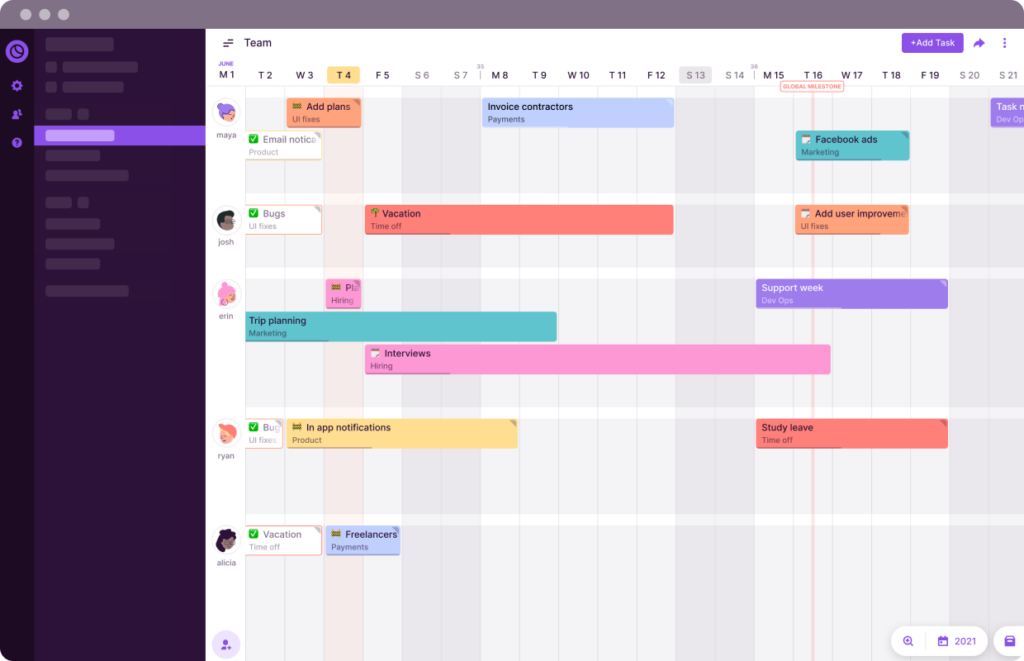
This gives clear visibility into your resource scheduling, timelines, and capacity. You can keep an eye on each team member and ensure that no one’s over or underworked.
Also, It doesn’t hurt to put some contingency plans in the works:
- Name a backup teammate for each task who can leap in if need arises
- Add buffer time to your initial time estimates
- Add breaks in between scheduled tasks
Breaks between tasks in a team member’s schedule are a solid way to prevent scheduling issues. Back-to-back tasks may not conflict, but they could cause burnout and lead to a teammate not working to their full potential.
Contingency time is key for all your time estimates. It helps with not only resource scheduling conflicts but also with our next point…
4. Meeting deadlines
A deadline is met when your team delivers on the promised date and time.
This may sound simple but it is one of the most common project management challenges. According to Capterra, 46% project managers say hitting deadlines is their biggest challenge.
And it comes with a slew of headaches you want to avoid:
- Deadline penalties are expensive and cumulatively result in project failure
- Clients become unhappy and often rethink about whether to continue working with you
- Team members are unhappy because they need to overwork to meet a deadline
Deadlines are often missed because of incorrect estimates (unrealistic deadlines, we’re looking at you), scope creep, or insufficient resources.
As an agency owner, you may not realize it, but your project teams may be struggling with scheduling-related project management challenges. Here’s how to spot them so you can help your project manager.
Signs that a deadline will not be met
It’s hard to miss a missed deadline. 😅
Jokes aside, you can always spot the signs of an impending missed deadline.
- Your team is anxious and strung whereas clients are unhappy
- People are working unreasonably long hours and over weekends
- Unusual mistakes lead to rework as shortcuts are taken
How to meet deadlines and deal with missed deadlines?
Okay, let’s hit both sides here—how to meet deadlines but also how to deal with one that’s already missed.
Experience from previous projects, past project reports, and time tracking tools are invaluable when determining deadlines. For example, gather data from previous projects about:
| How to meet deadlines? | How to deal with missed deadlines? |
|---|---|
|
|
- How long did a similar project take to deliver?
- What tasks went over the planned end date?
- How many buffer hours did your last project use?
Tracking tools enable you to record your experience with previous projects and use this information to plan new projects better.
One more point. If you do miss a deadline, remember that manners matter. A “sorry” and a “thank you for understanding” to the client go a long way. And this is true for all project management challenges. Once you know you’ve messed up, apologize on behalf of your team and take the steps to fix it.
5. Imbalanced workloads
80% of global knowledge workers report feeling overworked and close to burnout. And 82% feel less engaged when stressed at work.
Balanced workload management is crucial to happy teams delivering successful projects.
On the other hand, imbalanced workloads lead to:
- Burnout because of overworked team members
- Anxiety, stress, and disengagement resulting in quiet quitting
- Team conflicts with some team members working overtime while others slack
So how to detect imbalanced workloads before it affects your team and projects adversely?
Signs that your team is reeling under imbalanced workloads
- You have both over and underworked team members
- Team members are disengaged from work, show signs of stress, and aren’t up to their usual quality or communication standards
- Minor team conflicts here and there—may be not an all-out missed deadline, but quite a few close calls in a row
How to balance your team’s workload?
In the early stages of a project, workload management involves identifying your team’s existing capacity and planning work around it.
Once the project is in progress:
- Review timelines and tracked time to understand the planned vs actual workloads
- Encourage communication within your team to identify over and underworked team members
- Schedule regular 1:1 meetings to check in on your team members
And if your workloads still need rebalancing, here are some ways to do that:
- Identify team members who might temporarily want to put in extra hours
- Build capacity by training underworked team members on critical skills
- Redistribute work within your team to even out their workload
- If your team doesn’t have the capacity, outsource work to other agencies or freelancers
6. Burned-out team members
What is burnout? According to the World Health Organization: “a syndrome conceptualized as resulting from chronic workplace stress that has not been successfully managed”.
Because, yes—burnout isn’t just a cliche. It’s officially recognized and is one of the worst project management challenges, particularly if it isn’t taken seriously.
Burnout can result in:
- Exhaustion
- Lack of interest in work
- Feeling negative toward work
- Eventually leading to depression
One survey showed that 84% of millennials and 77% of all workers say they’ve experienced burnout at their current job. And about half of respondents say they’ve left a position solely due to burnout.
Signs that your team is heading for a burnout
- Drop in productivity
- Excessive absenteeism (only 3.2% workforce is absent on a regular day)
- Feeling apathetic or dissatisfied with work
- Excessive stress caused by deadlines
How to prevent team burnout?
The best way to prevent burnout is to prioritize your team before profits.
Don’t say “duh” just yet—this is easy to do without realizing it.
Actions like taking on extra projects when you may not have the resources. Or adding on additional work when it isn’t feasible are two sneaky ways that profits can get in front of your project team.
From far away, a smaller amount of projects, reduced scope, balanced workloads, and time off may look like a loss in revenue—but when you consider the increase in quality, the end result might just be more profitable.
Flexible working hours and regular time off can go a long way in preventing burnout. Emotional and mental health programs are becoming more recognized, with over 50% of companies implementing mental well-being programs.
7. Team conflicts
Workplace conflicts often occur as a result of overwork, stress, and imbalanced workloads.

Then there are disagreements. They’re impossible to avoid in a world of different opinions, beliefs, and cultures. Unlike conflicts, work-related disagreements often bring in different perspectives which can make the workplace better.
However, disagreements that are not work-related can often get out of hand and lead to bigger conflicts.
And, improper conflict management can lead to:
- Loss of productivity and efficiency
- Disengaged team members
- Friction between team members
- Lack of teamwork
Conflict is a natural part of working together, but things get ugly when conflicts get out of hand.
Signs of conflict in the workplace
- Dysfunctional project team meetings
- Excessive use of formal, asynchronous communication channels
- Behavioral change (includes words, comments, and complaints)
- Clique formation, complaints against others
- Drop in productivity
How to resolve conflicts in the workplace?
Understand it, manage it, and above all: expect it.
This is one of those project management challenges where you’ll need to rely on your interpersonal skills.
Here are a few key conflict resolution tips:
- Take a step back and assess the situation
- Schedule a meeting to discuss it (if it’s a larger conflict)
- Allow every side to speak and express themselves
- Stay calm and remain civil
- Be patient and listen
- Focus on the future and move past problems
Conflict management is an invaluable skill, and it comes in many different flavors. From compromising to accommodating to problem-solving—there’s a style of conflict management to suit every individual and their project team.
You can read about them in-depth in our blog post on conflict management tips.
8. Lack of coordination between team members
We’ve often heard: “Teamwork makes the dream work.”
So, a lack of coordination can be a serious detriment to a project team.
What causes a lack of coordination?
- Lack of clarity
- Team conflicts
- Working remotely
We’ve discussed the importance of visibility and resolving conflicts. But how does remote work lead to uncoordinated work?
Try scheduling a meeting with 3+ timezones and you’ll know what we mean.
And that’s just timezones.
Remote teams work across cultures, geographies, and political environments. Such differences are bound to create a dissonance in your project team.
Signs of lack of coordination in the team
- Team members frequently wait on tasks
- Team members keep to their own tasks and don’t look at the big picture
- Frequent disagreements when team members hand over work to others
How to improve coordination between your project team?
Use a visual project management tool that comes with a timeline, Kanban board, or calendar.
With a visual tool everyone in your project team:
- Knows who’s working on what and when
- Understands dependencies and make people accountable
- Has clarity about milestones and delivery deadlines
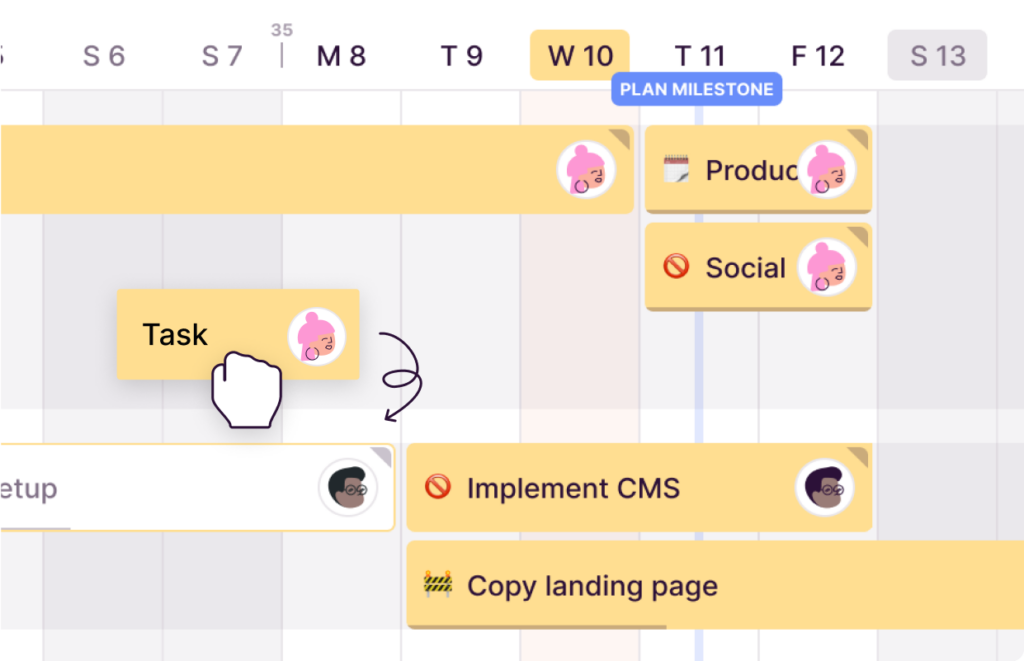
If your team works from home, invite them to offsite meetups where everyone can meet each other in person. Toggl has three offsite meetups every year.
There are several ways to build your team over online team calls too. Start meetings with fun, personal ice-breaker questions. Or arrange 1:1 coffee chats between team members to build camaraderie.
9. Missing accountability
Accountability means taking responsibility for actions, tasks, and issues. It’s about taking the initiative to acknowledge and do your part.
Lack of accountability results in missed deadlines, unhappy clients, and disengaged team members.
Building a self-driven, accountable project team has far-reaching benefits:
- Higher trust
- Higher productivity
- Increased engagement
- Lower turnover
- Higher motivation and morale
Signs of workplace accountability problems
- No one cares for milestones and deadlines
- Team members blame others (often factors beyond control) for missed deadlines
- The managers need to constantly ask for updates or need to micromanage
How to improve accountability in the workplace?
Set clear goals.
Establish what you’re trying to accomplish and who’s responsible for what. Giving a person a clear responsibility will instill a greater feeling of accountability.
Then, work to create a “safe space” culture.
What does that mean?
When your team knows that mistakes are met with patience, help, and encouragement it helps them feel safe. Encourage owning up and fixing mistakes. Provide help in the form of training or expert guidance where needed.
Only those who’re asleep make no mistakes. Making mistakes is the privilege of the active.
Ingvar Kampard, Founder of Ikea
One last tip for boosting accountability in the workplace:
Lead by example and be accountable yourself. Nothing encourages a team more than seeing a project leader who’s willing to take responsibility.
10. Getting your team to update PM software
There’s a reason that project communication goes astray—the reluctance or neglect to update your PM tool.
How often have you heard: “Yeah, I finished meeting with the client—but I’ll update the client feedback on the task tomorrow.”
Sometimes the tomorrow never comes. And if (and when) it comes, people have already forgotten to record a critical piece of information.
As a result, project information goes missing.
Here are a few of the reasons why people don’t update their PM tool:
- Updating project information feels unimportant, like a chore
- Inadequate training on how to use the tool efficiently
- No one cares about the updated information
What happens when your team doesn’t update the PM software
- It becomes difficult for you as a project manager to stay on top of project progress
- Compiling status reports takes multiple emails and discussions with team members leading to inefficiencies
- Lack of team coordination
How to get your team to update project information?
Choose a tool that makes it easy to update the project information.
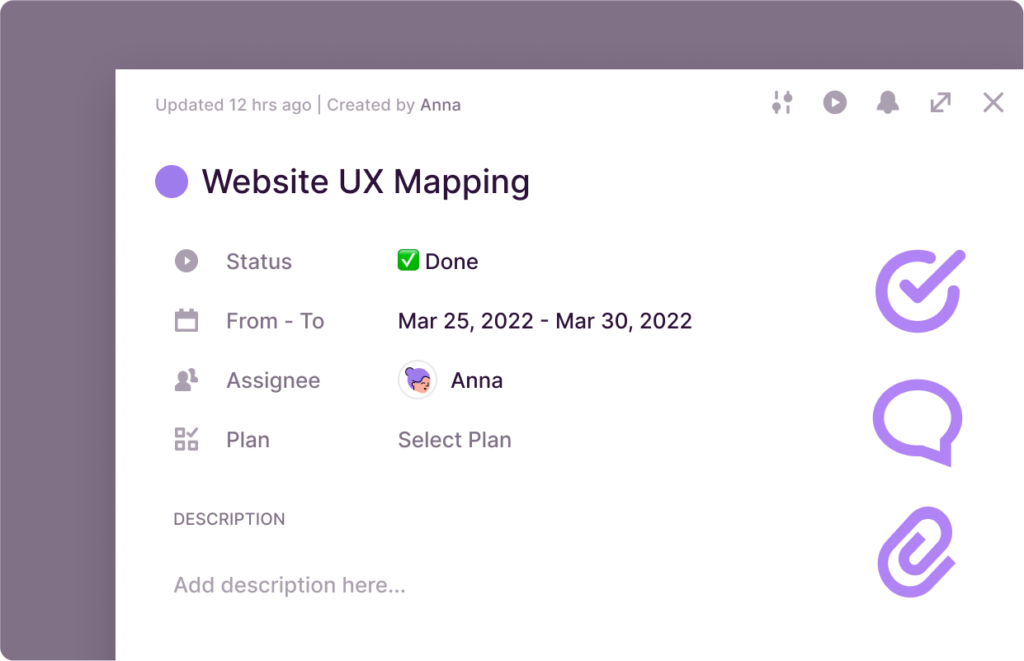
Update your project communication to include a “why/how/when to update the PM tool” to help teammates know what to do.
Involve your team members when selecting project management software. Find out what they like/don’t like instead of dumping your decision on them.
Conduct frequent best-practice training sessions to help your team use the tool effectively.
Quick recap of the biggest project management challenges
Here’s a quick summary for your reference.
| Challenge | Common Symptom | Solution |
|---|---|---|
| Scope creep | A constant need to adjust project schedule to meet new requirements | Document project scope and get client sign off |
| Lack of project visibility | Rework | Communicate, track, report, repeat |
| Resource scheduling conflicts | Missed deadlines or constant reprioritizing of resources and tasks | Invest in project management software that gives you clear visibility of your team’s schedule |
| Slipping deadlines | Clients and team members seem frustrated and unhappy | Create better estimates with historical project data and slack time |
| Imbalanced workloads | Both over and underworked team members | Build capacity by training underworked team members on critical skills |
| Burn out | Productivity loss, absenteeism, anxiety, and work-related stress | Prioritize your team before profits |
| Team conflicts | Dysfunctional teams; drop in productivity | Understand, assess, and resolve conflicts fairly |
| Lack of coordination | Team members frequently wait on tasks | Use a visual project management software |
| Missing accountability | Need to micro-manage employees | Set clear goals; lead by example |
| Keeping project info up to date | Project information is hard to find and track | Choose a project management tool that your team actually enjoys using |
Handle project management challenges with confidence
Challenges in project management happen to everyone, every day. Sometimes they just can’t be avoided.
What matters is identifying these challenges, preventing them wherever possible, and mitigating when they happen anyway.
No doubt, your skills as a leader will be tested.
But most project management challenges can be managed by using a visual project management tool. It helps bring clarity to work and helps your team deliver projects collaboratively.
Learn about the best visual project management tools next.

